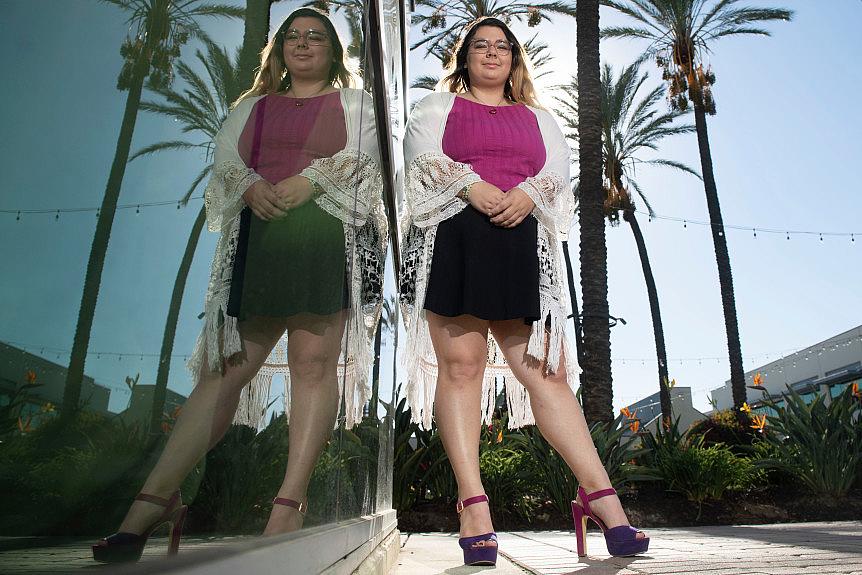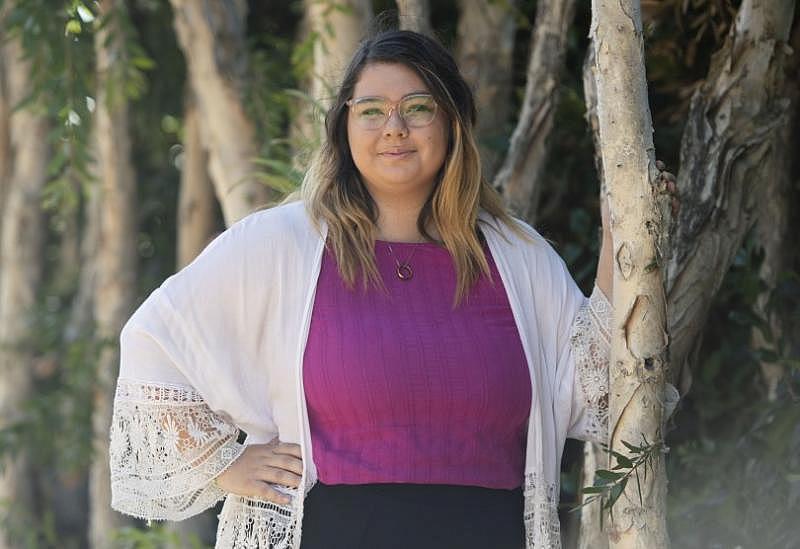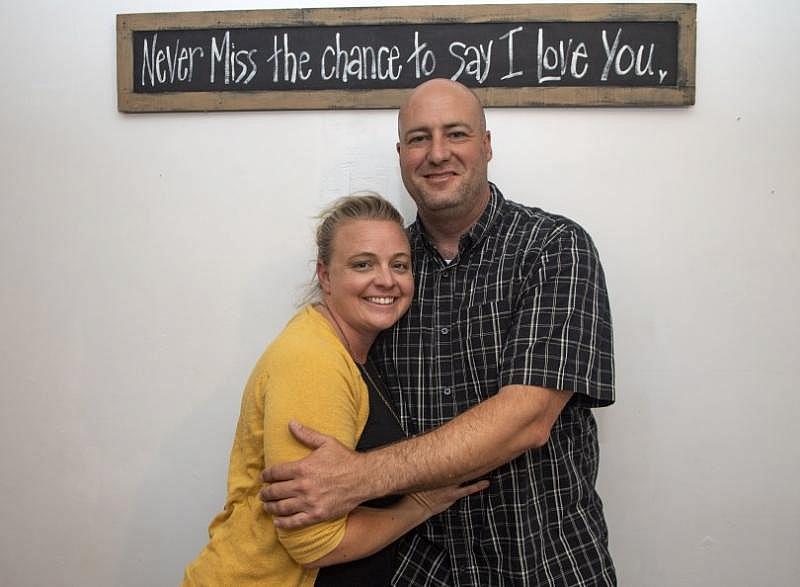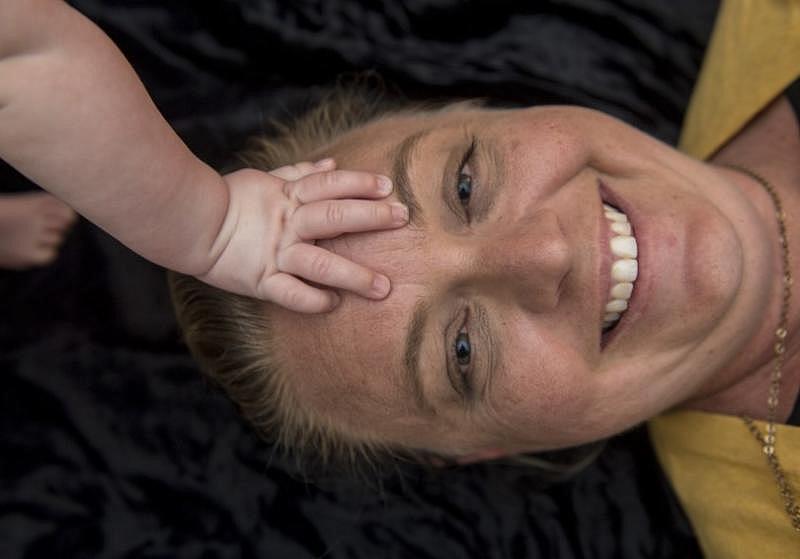Born on drugs: Predictions about crack babies didn’t come true, offering hope for opioid era
This series was produced with the support of the USC Annenberg Center for Health Journalism Impact Fund.
Other stories in this series include:
Born on drugs: The goal is to keep kids with parents. Sometimes, that’s dead wrong
Born on drugs: Babies from addicted moms are increasing at an alarming rate in California
Lawmakers vow to push stiffer regulations on addiction treatment in California

Nancy Palmer, 22, was a crack baby, meaning she was born exposed to crack cocaine. At a time when babies are learning to bond, doctors were trying to break her of her physical need for cocaine. She survived, was adopted by the man who runs the rescue mission, and now helps families facing the same crisis. Photographed at the Orange County Rescue Mission’s Village of Hope campus in Tustin on Thursday, October 18, 2018.
(Photo Credit: Kevin Sullivan, Orange County Register/SCNG)
By Tony Saavedra and Scott Schwebke
To the courts, she was just a case number.
It was impersonal because, at the time, she was one in a long line of “crack babies,” which is what newborns like her were called in 1996.
Today, she has a name; Nancy Elizabeth Palmer. And even though she came into the world with little chance of surviving her birth mother’s addiction to crack (along with methamphetamine and opioids and anything she could get her hands on), Palmer is more than OK.
These days, the condition is known as “neonatal abstinence syndrome,” and it describes a newborn who has been exposed, in utero, to a harmful drug or alcohol.
And data does show that children can die, or experience profound physical difficulties, as a result of being exposed to drugs in the womb. A 2008 study in Tennessee found that drug-exposed infants are more likely to develop learning disabilities and stay in the hospital much longer, an average of 16.9 days compared to 2.1 days for other newborns.
Other studies show that drug-exposed babies cost hundreds of thousands of dollars to keep alive as newborns and even more money in health expenses later in life.
But when the “crack baby epidemic” of the 1980s and ’90s was raging, many experts offered stark, long-term forecasts, saying the United States of the early 21st century would include a population of drug-exposed people who grew up with permanently impaired brains and psyches.
That didn’t come true. And a 2016 report by the National Institute on Drug Abuse found those earlier forecasts were wildly overblown.
“Dire predictions of reduced intelligence and social skills in babies born to mothers who used crack cocaine while pregnant during the 1980s — so-called “crack babies” — were grossly exaggerated,” NIDA researchers wrote.
“However, the fact that most of these children do not show serious overt deficits should not be overinterpreted to indicate that there is no cause for concern.”
Palmer is an example of how good medical treatment — and even better parenting — can help turn a tough start into a great life.
Different outcome
Nancy Palmer, 22, was a crack baby, meaning she was born exposed to crack cocaine. At a time when babies are learning to bond, doctors were trying to break her of her physical need for cocaine. She survived, was adopted by the man who runs the rescue mission, and now helps families facing the same crisis. Photographed at the Orange County Rescue Mission’s Village of Hope campus in Tustin on Thursday, October 18, 2018. (Photo Credit: Kevin Sullivan, Orange County Register/SCNG)
“The doctors didn’t think I was going to make it. And if I did make it, I wouldn’t be able to function properly,” said Palmer, now a 22-year-old communications senior at Concordia University who plans to become a licensed drug and alcohol counselor.
Aside from some nerve damage, Palmer is surviving with few problems.
Fostered and then adopted by Orange County Rescue Mission CEO Jim Palmer and his wife, Michelle, Nancy Palmer is trying to give back to the addicted community that created her.
The number of drug-exposed infants born in California nearly tripled over the decade between 2008 and 2017, from 1,862 to 5,050. In Orange County, where Nancy lives, the number jumped from 84 in 2008 to 192 in 2017.
Nancy knows little about her birth mother; even less about her birth father. “He’s just a name on the birth certificate.”
Jim Palmer tried to help the birth mother regain custody, when Nancy was little, but the woman just stopped coming to court. So the Palmers nurtured the baby, who suffered as many as 15 seizures a day even as a toddler.
“My heart was going out to this little baby girl,” said Jim Palmer. “The first time I held her she was going through a seizure.”
The seizures damaged her nerve endings, says Nancy. As a toddler, she would walk into walls and not feel a thing.

“I have a very high pain tolerance,” Palmer says. “My nerves are still fried.”
After six weeks in a hospital, Palmer was placed in Olive Crest, a children’s home system, where Jim Palmer found her in 1996. His family previously had fostered two boys and later fostered another girl. All were ultimately adopted.
Doctors didn’t know how the drug exposure would affect Nancy’s brain growth. But, aside from dyslexia and an allergy to tobacco, Nancy Palmer says she turned out pretty much normal.
“I grew up like any other child, maybe just a little more hyper,” she says. “I beat the odds. They said I wouldn’t live past 3 years old. Now, I’m 22 and going to college.”
For awhile, she hated her birth mother; hated that she couldn’t beat her addiction to win back her baby girl. But, today, Nancy speaks of that “hatred” in the past tense.
She’s made peace with her life, noting that “everybody deserves a second chance.”
“Because your parents made a mistake, doesn’t mean you’ll make the same mistake.”
Family structure
Melissa and Andrew Ferguson have adopted 3 drug-exposed babies and are currently the foster parents to a 4-month-old boy in Buena Park on Tuesday, July 31, 2018. (Photo Credit: Mindy Schauer, Orange County Register/SCNG)
Think of people like Melissa and Andrew Ferguson as the safety net in the opioid era.
The Buena park couple is too young to have raised any “crack babies,” but over the past decade or so they have been foster parents to dozens of other drug-exposed babies, giving each a fresh start on life.
On a wall inside their Buena Park living room, above two well worn brown sofas, hangs a sign that reads “Family is Forever.” It’s more than a feel-good slogan; for the Fergusons, the three words are a lifestyle.
“We build an extension of our family with all the littles that come through our door and their families,” said Melissa Ferguson, 36.
“Even after our time is over with loving these littles, and helping to encourage their parents, we let them know they can always call if they need us.”
On occasion, the Fergusons have found it impossible to say goodbye.
They have adopted three of their one-time foster children, rounding out a family that also includes two biological children, a 12-year-old son and 10-year-old daughter.
“It wasn’t that we wanted to save a child as much as we wanted to build our family,” Melissa said. “We wanted a child that just needed a family.”
In 2013, the couple attended a workshop led by experts at the Orange County Department of Social Services. It was aimed at recruiting foster parents to care for children who’d been exposed to drugs at birth.
They learned about the challenges those children often face, and the difficulties that caring for such children can wreak on many families. They painted a tough — even bleak — picture of what it’s like to care for children who have been removed from the care of their biological parents.
“They give you the worst-case scenario,” said Andrew, 39. “They try to scare you off.”
Still, Melissa left the meeting with one idea in her head:
“I thought, ‘We can do this!’”
For a nine-week stretch, the Fergusons diligently attended foster care classes. They learned how to help children handle emotional and physical trauma. They learned about visitation rights. They learned about child attachment issues.
County officials also thoroughly interviewed the Fergusons and their two biological children, as well as family and friends.
“They look at everything in your life,” Melissa said.”They want to make sure you are capable of integrating them into your life.
About five weeks after the last class the Fergusons became licensed foster parents. Soon after that — around 3 p.m on Halloween of 2013 — their small family doubled in size.
A social worker phoned Melissa and told her a 5-year-old boy and his 2-year-old sister, who had been removed from their home, were in immediate need of a foster family.
Melissa and Andrew raced to DSS headquarters in Santa Ana to pick up the children.
While the girl was happy with the Fergusons, her brother had difficulty adjusting.
“We had them three weeks,” Melissa recalled.
Soon, a foster child came to the Fergusons’ home to stay longer. Others followed, some leaving after a short period, some staying longer.
The easiest part
One who stayed was Matthew.
His 20-year-old biological mother used methamphetamine, alcohol, and marijuana during her pregnancy leaving him severely exposed to drugs.
Despite the medical challenges, the Fergusons knew they wanted to adopt him.
“Once we got him, I was on board,” Andrew said.
Melissa quit her job as a medical assistant to keep up with Matthew’s numerous medical appointments.
His sight and hearing were compromised; his neurological development was uncertain. He suffered from seizures.
It took a year for Matthew to crawl, and about seven months after that before he could walk. And even when he could walk his muscle tone was so delayed that he needed leg braces to get around.
Melissa Ferguson and her husband Andrew have adopted 3 drug-exposed babies and are currently the foster parents to a 4-month-old boy, pictured, in Buena Park on Tuesday, July 31, 2018. (Photo Credit: Mindy Schauer, Orange County Register/SCNG)
Since then, however, he has made remarkable progress.
“He overcame everything they (doctors) told him he would not overcome,” Melissa said proudly. “He beats his own drum. He was slightly behind everyone, but charged through. Now he is off the charts and doing really good.”
Still, the Fergusons had more love to give. On June 7, 2018, they adopted two girls, both of whom were born exposed to methamphetamine.
The girls, Amelia and Zoe, each about 2 when they came to the Fergusons, aren’t biologically related. And their medical challenges aren’t as severe as those faced by Matthew.
“Zoe is our girly girl and Amelia is our sassy little butterfly,” Melissa said.
The Fergusons don’t plan to adopt any more children. But they say they will continue providing a loving foster home to children and offer any support they can to the biological parents.
“Everyone assumes opening up your heart is the hardest part to fostering,” she said.
“Little do they know, that’s the easiest.”
[This story was originally published by The Orange County Register.]

